Today’s news is about observations I have made when communicating with goat owners seeking advice through the Ask and Expert feature of this website. These observations have led me to hypothesize that chickens harbor microbes, probably members of the mycobacteria family, that trigger false-positive ELISA results. Here’s a real-world case using a fictitious owner name but with diagnostic test results that are real, with all owner and goat details removed.

Recently Sally wrote to me saying:
After years of negative tests, I just had 5 out of 11 goats (all goats here that are at least a year old) test positive for Johne’s and many of the others not being far away from the 0.800 threshold to consider them positive as well. All of them are easy keepers and fat and sleek with no sign of Johne’s.
These are the ELISA results Sally provided to me with S/P values and the laboratory’s interpretation (S/P values >0.800 being positive).
Goat #1, S/P value 0.491, negative
Goat #2, S/P value 1.459, POSITIVE
Goat #3, S/P value 0.851, POSITIVE
Goat #4, S/P value 0.610, negative
Goat # 5, S/P value 0.250, negative
Goat #6, S/P value 0.887, POSITIVE
Goat #7, S/P value 0.516, negative
Goat #8, S/P value 0.318, negative
Goat #9, S/P value 0.959, POSITIVE
Goat #10, S/P value 1.290, POSITIVE
Goat #11, S/P value 0.656, negative
This report shows an apparent prevalence of 5/11 (45%) equating to 100% true prevalence and the positive predictive value of 100% for the positive tests. These values assume an ELISA sensitivity of 25% and specificity of 98%. The estimated true prevalence and positive predictive value were calculated using Epitools.
https://epitools.ausvet.com.au/trueprevalence
I explained to Sally that the Johne’s disease ELISA is a rapid, low-cost screening test for Johne’s disease but to confirm a diagnosis I recommended she have a fecal PCR done on the ELISA-positive goats. Sally sent fecal samples to a USDA-approved laboratory and all 5 results came back “negative”; MAP not detected.
Sally’s story is not unique. In fact, I have encountered at least a dozen such similar stories of a surprising number of ELISA-positive goats with 100% negative fecal PCR results. The common denominator has always been goats that share an environment with chickens. This is purely an observation, but I speculate that backyard poultry harbor microbes that infect goats sufficiently to trigger antibody that reacts in the Johne’s disease ELISA but is not MAP and does not cause the goats to get sick.

Like Sally, most of the goat owners in this situation are breeders, meaning they sell live animals for breeding purposes. Because of the low sensitivity of the ELISA and the significant chances of false-positive results on farms where there are poultry, I strongly urge all breeders to avoid using the ELISA and instead use the fecal PCR. I also urge them to test all adult animals in their herd annually. It is vital that breeders do not sell MAP-infected goats for the sake of their business and the sake of their particular goat breed. Thus, they should invest in the best diagnostic test for Johne’s disease available and test their herd annually, always using USDA-approved labs.
To limit the cost of this diagnostic testing, owners should use laboratories that offer to do sample pooling. The owner or his/her veterinarian submits individual fecal samples. The laboratory then pools equal amounts of feces from 5 goats, ideally based on age (5 oldest goats in the first pool, etc.) and does a single PCR on the fecal pool. If the PCR is negative, then all the goats contributing to that pool are declared negative, i.e., no MAP detected in feces.
Prices for these laboratory tests vary but using WVDL rates for 2021 I made cost some cost comparisons. The cost of pooled PCR for Sally’s 11 goats would be $70.04 for 2 pooled PCRs for the first 10 goats (5/pool) and $30.89 for the individual PCR on the 11th goat for a total of $100.93 (plus a $10 accession fee). This equates to a cost of $10.08/goat. The cost of doing an ELISA on these goats at the WVDL would be $6 x 11 plus $10 = $76 or $6.91/goat. Note: had Sally’s herd been only 10 goats the per goat cost for pooled PCR would have been only $7.28.
In sum, pooled fecal PCR is the test of choice for goat breeders. It is roughly 3 times more sensitive (better able to detect MAP-infected goats), has higher specificity (rare false-positives) and is comparable in cost to the ELISA when sample pooling is done by the lab.
My “chicken theory” is just that, a theory based on observations when working with goat owners who have unexpected positive ELISA results. I hope that some talented young researcher will explore this further. Perhaps the microbe triggering these false-positive ELISAs would be a candidate for a live avirulent vaccine for Johne’s disease.